Warsaw University of Technology
Politechnika Warszawska | |
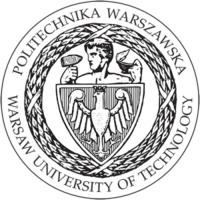 | |
| Type | Public |
|---|---|
| Established | 1826 |
| Rector | Krzysztof Zaremba[1] |
Academic staff | 2,388[2] |
| Students | 20,851[3] (12.2023) |
| Undergraduates | 26,284[2] |
| Postgraduates | 4,698[2] |
| Address | pl. Politechniki 1, 00-661 , , Poland 52°13′13″N 21°0′38″E / 52.22028°N 21.01056°E |
| Affiliations | EUA, EucA, PEGASUS, CESAER, BEST |
| Website | www |
 | |
The Warsaw University of Technology (Polish: Politechnika Warszawska, lit. 'Varsovian Polytechnic') is one of the leading institutes of technology in Poland and one of the largest in Central Europe. It employs 2,453 teaching faculty, with 357 professors (including 145 titular professors).[4] The student body numbers 36,156 (as of 2011), mostly full-time.[4] Its 19 faculties (divisions) covering almost all fields of science and technology are located in Warsaw, with the exception of one, which is in Płock.
The Warsaw University of Technology has about 5,000 graduates per year. According to the 2008 Rzeczpospolita newspaper survey, engineers govern Polish companies. Warsaw Tech alums make up the highest percentage of Polish managers and executives. Every ninth president among the top 500 corporations in Poland is a graduate of the Warsaw University of Technology. Professor Kurnik, the rector, explained that the school provides a solid basis for the performance of managers by equipping its students with an education at the highest level and a preparation with the tools and information, including knowledge of foreign languages.[5]
The origins of Warsaw University of Technology date back to 1826 when engineering education was begun in the Warsaw Institute of Technology.
In 2018, Times Higher Education ranked the university within the global 601–800 band.[6]
History
[edit]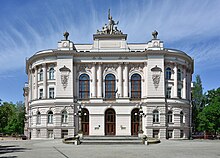
1826–1831
[edit]The origins of Polish universities of technology go back to the 18th century. They were related to either military technology or mining, which demanded complicated technological processes as a result of the exploitation of deeper seams. The model school of technology, a university of technology, was designed by the French, who in 1794 founded the Ecole polytechnique, in Paris. In the beginning of the 19th century, universities of technology were opened in Prague (in 1806), Vienna (1815), and Karlsruhe (1824).
In Poland, the first multidisciplinary university of technology was the Preparatory School for the Institute of Technology, which opened on 4 January 1826. The Warsaw University of Technology still cultivates its traditions. The man who played the most important part in creating the school and writing its charter was Stanisław Staszic. Kajetan Garbiński, a mathematician and Warsaw University professor became the director. The school was closed in 1831, after the November Insurrection.
1898–1914
[edit]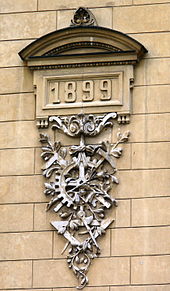
In 1898, the Technological Section of the Warsaw Society for Russian Commerce and Industry, whose director was engineer Kazimierz Obrębowicz, collected funds for the opening of Emperor Nicolas II University of Technology. Classes, with Russian as the language of instruction, started on 5 September in the building at 81 Marszałkowska Street. They were soon moved to new buildings, built especially for the institute. They were designed by Bronisław Rogóyski and Stefan Szyller.
On the day of its opening, the university had three faculties: Mathematics, Chemistry, as well as Engineering and Construction. In June 1902, the Faculty of Mining was opened. Poles constituted the majority of students until 1905 when their number reached 1,100.
1915–1939
[edit]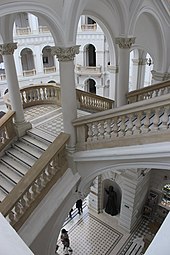
After German troops entered Warsaw on 5 August 1915, they wanted to gain the sympathy of Poles and allowed University of Warsaw and the Warsaw University of Technology to open with Polish as the language of instruction. The grand opening of both universities was held on 15 November 1915. Zygmunt Straszewicz was the first rector of the Warsaw University of Technology. World War I, together with the events connected with the restitution of the Polish State and the Polish-Bolshevik war, did not help the development of the school. Daily lectures only started in November 1920. The school taught the young future engineers at the faculties of Mechanics, Electrical Engineering, Chemistry, Architecture, Civil Engineering, Aquatic Engineering, and Geodesy (or, since 1925, Measuring). The last three faculties were merged on the basis of the new Academic Schools Law of 13 March 1933. The Polish Cabinet issued a decree on 25 September 1933, in which the new Faculty of Engineering was created.
The number of the Warsaw University of Technology students in the 20 years between the wars grew from 2,540 in the 1918/1919 academic year to 4,673 just before the outbreak of World War II. In the same period, the school granted more than 6,200 diplomas, including 320 for women. The Warsaw University of Technology became the most important scientific centre of engineering in Poland and gained international prestige. At that time, 66 graduates earned Doctor of Philosophy degrees, and 50 qualified as assistant professors. The university was a centre of scientific research for people whose achievements were fundamental for world science and technology, including Karol Adamiecki, Stefan Bryła, Jan Czochralski, Tytus Maksymilian Huber, Janusz Groszkowski, Mieczysław Wolfke and many others.
1939–1945
[edit]During World War II, despite enormous material losses and repressive measures, the Warsaw University of Technology continued to operate underground. Teaching continued in clandestine and open courses, in vocational schools, and from 1942, in a two-year State Higher Technical School. Approximately 3,000 students took part in the clandestine courses and 198 earned engineer diplomas. Scientific research was conducted, as 20 PhD and 14 assistant-professorship qualifying theses were written. Considerable work served the reconstruction of Poland after the war and constitute the foundation for the development of science. Students and professors secretly worked on projects. Professors Janusz Groszkowski, Marceli Struszyński, and Józef Zawadzki conducted a detailed analysis of the radio and steering devices of the German V-2 rockets, at the request of Polish Home Army Intelligence.
1945–present
[edit]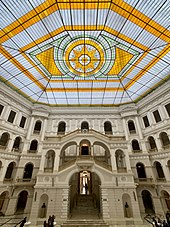
| University rankings | |
|---|---|
| Global – Overall | |
| ARWU World[7] | 801–900 (2020) |
| CWTS World[8] | 598 (2022) |
| QS World[9] | 511–520 (2021) |
| THE World[10] | 1001+ (2020) |
| Regional – Overall | |
| QS Emerging Europe and Central Asia[11] | 14 (2022) |
After German troops were dislodged from Warsaw, classes started in improvised conditions on 22 January 1945. By the end of the year, all the pre-war faculties were re-opened. Old and war-damaged buildings were rebuilt quickly; new ones were erected. In 1951 the Warsaw University of Technology incorporated the Wawelberg and Rotwand's School of Engineering.
The Academic and Research Centre in Płock was created in 1967.
In 1945 there were 2,148 students in six faculties (divisions). By 1999 there were 22,000 students enrolled in 16 faculties. The Warsaw University of Technology granted over 104,000 Bachelor of Science and Master of Science engineer degrees between the years 1945 and 1998.
Over the years, the university was an important scientific centre, educating academic staff for its own purposes and for other Polish schools of technology. Between 1945 and 1998, 5,500 PhD theses were written. There were almost 1,100 theses qualifying for assistant professorships. The number of academic staff grew significantly. In 1938, the university had 98 tenured professors and associate professors, as well as 307 assistant professors and teaching assistants; in 1948 there were 87 and 471; while in 1999 there were 371 professors, 1,028 tutors, 512 lecturers, and 341 teaching assistants.
Faculties
[edit]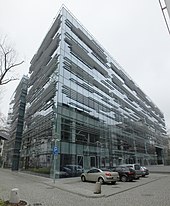
- Faculty of Administration and Social Science[12]
- Faculty of Architecture
- Faculty of Automotive and Construction Machinery Engineering
- Faculty of Chemical and Process Engineering
- Faculty of Chemistry
- Faculty of Civil Engineering
- Faculty of Electrical Engineering
- Faculty of Electronics and Information Technology
- Faculty of Building Services, Hydro and Environmental Engineering
- Faculty of Geodesy and Cartography
- Faculty of Mathematics and Information Science
- Faculty of Management
- Faculty of Materials Science and Engineering
- Faculty of Mechatronics
- Faculty of Production Engineering
- Faculty of Physics
- Faculty of Power and Aeronautical Engineering
- Faculty of Transport
- WUT Business School[13]
Płock Campus:
- Faculty of Civil Engineering, Mechanics and Petrochemistry
- College of Economics and Social Sciences
Transport
[edit]The transport faculty is engaged in research into the development of railway variable gauge axles which help overcome breaks of gauge, such as the SUW 2000 system and INTERGAUGE.
Notable alumni
[edit]- Tomasz Bagiński (born 1976) – illustrator, animator and director
- Ryszard Bartel (1897–1982) – engineer
- Mieczysław G. Bekker (1905–1989) – engineer and scientist
- Antoni Bohdziewicz (1906–1970) – screenplay writer and director
- Joanna Chmielewska (1932–2013) – novelist and screenwriter
- Zofia Garlińska-Hansen (1924–2013) – architect
- Patricia Kazadi (born 1988) – actress, singer, dancer, and television personality
- Antoni Kocjan (1902–1944) – glider constructor and Home Army soldier during World War II
- Vadim Komkov (1919–2008) – mathematician
- Alfred Korzybski (1879–1950) – engineer, mathematician and philosopher
- Bohdan Kulakowski (1942–2006) – mechanical engineer, professor at Pennsylvania State University
- Stefan Kurylowicz (1949–2011) – architect and professor of architecture[14]
- Jan Lenica (1928–2001) – graphic designer and cartoonist
- Henryk Magnuski (1909–1978) – telecommunications engineer
- Myron Mathisson (1897–1940) – theoretical physicist
- Zbigniew Michalewicz – computer scientist, entrepreneur
- Zenon Mróz (born 1930) – materials science engineer
- Witold Nazarewicz (born 1954) – nuclear physicist
- Henryk Orfinger (born 1951) – entrepreneur
- Waldemar Pawlak (born 1959) – politician, former Prime Minister of Poland
- Przemysław Prusinkiewicz – computer scientist
- Andrzej Piotr Ruszczyński (born 1951) – applied mathematician
- Mohamed Omar Salihi (1952-2021) - marine scientist
- Maciej Matthew Szymanski (1926–2015) – architect in Canada
- Jan Holnicki-Szulc (born 1945) - structural engineer
- Andrew Targowski (born 1937) – Polish-American computer scientist
- Andrzej Tomaszewski (1934–2010) – historian of art and culture
- Andrzej Trautman (born 1933) – mathematical physicist
- Władysław Turowicz (1908–1980) – Polish-Pakistani aviator, military scientist and aeronautical engineer
- Michał Vituška (1907–1945) – Belarusian leader of the Black Cats
- Marian Walentynowicz (1896–1967) – architect, graphic designer and comic book pioneer
- Stanisław Wigura (1903–1933) – aircraft designer and aviator
- Tomasz Wiktorowski (born 1981) – tennis coach[15]
- Zbigniew Zapasiewicz (1934–2009) – actor, theatre director and pedagogue
- Józef Zawadzki (1886–1951) – physical chemist[16]
See also
[edit]References
[edit]- ^ "Professor Krzysztof Zaremba elected the Rector of Warsaw University of Technology". Retrieved 4 November 2020.
- ^ a b c "Quacquarelli Symonds Top Universities", School Profile, undated Archived 2008-10-06 at the Wayback Machine, retrieved on 2008-09-13.
- ^ "Higher education in the 2023/24 academic year" (in Polish). Statistics Poland. Retrieved 2024-06-29.
- ^ a b "Basic Facts". Warsaw University of Technology. Retrieved October 25, 2011.
- ^ Błaszczak, Anita; Grochola, Anita; Cieślak-Wróblewska, Anna (2008-05-28). "Techniczne kuźnie prezesów". Rzeczpospolita (in Polish). Retrieved 2008-05-30.
- ^ "World University Rankings". Times Higher Education (THE). 18 August 2017. Retrieved 25 May 2022.
- ^ "ARWU World University Rankings 2020 | Academic Ranking of World Universities 2020 | Top 1000 universities | Shanghai Ranking - 2020". Archived from the original on 2020-08-15.
- ^ "CWTS Leiden Ranking 2022". leidenranking.com. Retrieved 2023-04-04.
- ^ "QS World University Rankings 2021".
- ^ "World University Rankings". 20 August 2019.
- ^ "QS World University Rankings-Emerging Europe & Central Asia". Retrieved 15 January 2023.
- ^ "Faculty of Administration and Social Sciences / Faculties / Academics / Home - Warsaw University of Technology".
- ^ "Warsaw University of Technology Business School". Retrieved 26 May 2022.
- ^ Scislowska, Monika (2011-06-07). "Leading Polish architect dies in plane crash". Seattle Post-Intelligencer. Associated Press. Retrieved 2011-06-19.
- ^ "Nasz absolwent Tomasz Wiktorowski Trenerem Roku 2022 w Polsce" (in Polish). Warsaw University of Technology. 2023-01-09. Retrieved 2023-01-09.
- ^ Sauer, T.; Trautman, A. (2008). "Myron Mathisson: What little we know of his life". arXiv:0802.2971 [physics.hist-ph].
